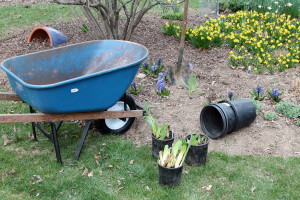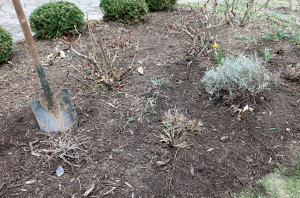Musical Chairs – The Plant Version
April 5th, 2016
Don’t feel like a failure if you find yourself moving plants this spring – again.

Do plants enjoy a ride in the wheelbarrow every now and then?
This is a normal part of gardening and one that’s not only an excellent way to learn, but a key way to tweak your landscape so that it keeps getting better and better.
Think of it as the horticultural equivalent of editing.
If it makes you feel any better, know that I’m constantly playing musical chairs with my plants.
It’s something I do every fall and every spring and is one of my favorite parts of gardening.
I’ll keep an eye on how things are performing and how they look in the overall landscape.
If a plant isn’t doing well, I’ll evaluate whether it’s not getting enough sun (or too much) or whether it’s not happy near that big cherry tree or getting blasted by a little too much northwesterly wind.
A lot of the time, a move to a more suited location is like injecting it with a steroid. A happier location often turns a laggard into a decent performer – or at least a barely passable one.
If a move doesn’t help, I’ll usually try a third and different location.
By then, if the thing isn’t coming around, the fourth stop is the compost pile. A three-strikes-and-you’re-out rule seems fair to me.
Sometimes I’ll move a plant because it’s getting too big and trims are no longer an option.
This happens a lot to me because I get small trial plants every year (many of them shrubs), and I just don’t have the long-term space to grow all of them to infinity and beyond.
So what I’ll do is tuck them into a limited space to see how they do for the first few years.
If they’re doing well and showing promise, I try to find them a more spacious long-term home. If they’re marginal performers or worse, I’ll either give them to someone else to try or send them to “horticulture heaven” (a.k.a. the compost pile).
With trial plants, the animals, weather and bugs weed out a fair number of candidates before I ever get to the size dilemma.
I suppose some gardeners would mourn the loss and/or composting of trial plants, but the way I look at it, it frees space for the next crop of hopefuls.
Sometimes my landscape plants get moved not because they’re losers or outgrowing the space but because I realize they’ll look better somewhere else.
If I’m lucky, I pick good partners in the first place. But more often than not, I realize that that patch of rosy-pink lilies, for example, would pair nicely with the purple alliums out front instead of by themselves next to a holly in the side yard.
I’m constantly on the lookout for better ways to pair the plants I already have. Sometimes I like to move plants that give life to a dead time in a bed, while other times I like to move a plant that has a coordinating color and a bloom time that matches an existing plant.
If you know all of those intricate plant habits, you’ll be more likely to hit ideals on the first try. But I’ve found it’s much more realistic for most people to plant, observe, then move things when they see how it’s all shaking out.

I’m guessing that my “edit” of grouping lavenders by the roses will be an improvement this year.
Just last week, I realized a pair of new Yuki Cherry Blossom deutzia growing along a west-facing brick wall would look and perform better on the shady side of three Double Pink Knock Out roses growing out front. So I moved the deutzias out front and filled the emptied spot with a pair of irises that were outgrowing the front bed anyway. The irises will bloom just before the neighboring brick-wall roses take off, making for good bloom timing.
I also gathered seven different trial lavenders that I had planted at different times in several beds and massed them together on the front side of the same Double Pink Knock Out roses. That’s space where I had been planting annuals every year.
The new mass of lavenders not only should give more impact than being scattered but should look nice paired with pink roses. It’ll also cut down on the number of annuals I’ll have to buy and plant this May.
Maybe non-gardeners look at this kind of constant reshuffling as never-ending work and a good reason why to let as much of the yard in grass as possible.
Rookie gardeners also tend to shy away from moves because they think there’s a good chance they’ll kill a plant that they dig up.
To me, it’s fun, creative and challenging – sort of a like solving a horticultural puzzle.
I look forward to it and figure it’s also good exercise in the fresh air.
As for killing plants by moving them, that rarely happens. I’ve had a very high rate of survival, especially when moving plants while they’re still young and timing the moves to early spring and early fall.
Another key is treating a moved plant like a new one, particularly keeping the soil around it consistently damp for the first year or two after a move. For more tips on how to move plants, check out a past article I wrote on “Transplantaphobia.”
Maybe some year I’ll be smart enough to guess right on the first try more often, but for now, I always feel better when I hear even top designers and Master Gardeners admit that they’ve moved every plant in their yard a minimum of three times.
Or as Lower Paxton Twp. gardener and horticulturist David Wilson once told me, “My plants like to go for a ride in the wheelbarrow every few years.”







